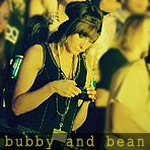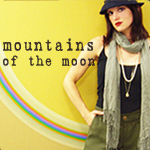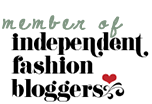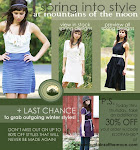No, that's not the sound of a little summer birdy outside of our office window (let's face it, we never got much of a summer here in Chicago anyway). It's the sound of our eco-fabulous Twitter page. Do you follow us yet? If you like things like special eco-fashion discounts and giveaways, sustainable fashion news and views, and witty banter, you should.
That's all for now. But stay tuned...
xo
Monday, August 31, 2009
Monday, August 17, 2009
The Fall/Winter Collection... Coming Soon to a Boutique Near You

1. The Samantha Dress in Deep Purple. Organic Cotton Knit. Low-impact Dyed. Made in the USA.
2. The Coco Dress in Black/Periwinkle. Hemp/Tencel Woven. Low-impact Dyed. Made in the USA.
3. The Ellie Skirt in Black. Hemp/Tencel Woven. Low-impact Dyed. Made in the USA. Shown w/a custom strapless wrap top, made by Melissa Baswell from a recycled vintage scarf.
Stay tuned for these fine eco-friendly garments, joined by the Olivia Top, Heidi Capelet, and more, available in beautiful, rich and vibrant colors like American Beauty, Steel, Deep Purple, Periwinkle, and Black (with a splash of Plaid and Gingham organic cotton + recycled buttons and trims). All sustainable, all made in the USA, sweatshop-free.
This IS smart.sustainable.style. Get it at www.mountainsofthemoon.com or your favorite eco-boutique in just a few short weeks.
Fabric Trash into Fashion Treasure
This piece by Mountains of the Moon President/Designer Melissa Baswell was originally featured on Green By Design, an amazing blog with an amazing mission: to harness our collective intelligence, creativity, and integrity to help protect the planet.
My beginnings as a designer in my tiny college apartment consisted mainly of reworking gently used thrift store clothing into one-of-a-kind designs, utilizing every possible scrap of excess fabric and spare button to its fullest. While interning at an environmental nonprofit, I gained an awareness of the negative environmental impact that certain aspects of the fashion industry had (mainly pesticide use and water waste in conventional fabrics), but it was difficult to find chic sustainable textiles at the time.
As the eco-fashion movement slowly began to gain momentum and cross genre boundaries, new fabrics became available, and my focus shifted from reworking used clothing into creating full collections from sustainable textiles. It was at this time that I began to work more with patterning and manufacturers, and was introduced to the incredible amount of fabric waste being generated by the fashion industry.
I quickly realized that true sustainable fashion is multi-faceted, and made a vow to always include four important elements in all of my collections:
(1) sustainable fabrics,
(2) timeless designs that would allow my clothing to be worn for years,
(3) sweatshop-free labor, and
(4) as little fabric waste as possible.
So how does a designer find imaginative ways to be less wasteful when it comes to fabric?
1. Be conscious when creating patterns and markers. Design them to utilize the fabric in a way that minimizes wasted space and edges.
2. Be original and reuse scraps within your designs. I love turning fabric scraps into embellishments or detailing on my designs, especially when it transforms a piece from my collection into an instant one-of-a-kind garment.
3. Be creative and reuse scraps for other projects. I create my hangtags from 100% recycled stock designed to be bookmarks (rather than a regular hangtag, which would ultimately be pulled off the garment and tossed), and use leftover fabric to create the bookmark ribbons.
4. Be resourceful and use salvaged fabric from others. Visit a local cut and sew factory and ask if they will sell (or even give) you leftover fabric that would be otherwise dumpster bound.
5. Be aware in your design work of how to transition from season to season without being distracted by fads. Find ways to carry certain fabrics over from collection to collection so the problem of excess fabric becomes a solution (too much slate organic cotton jersey from spring becomes less slate organic cotton jersey needed for fall).
It is reassuring to see many designers finally beginning to incorporate sustainability into their lines, but ultimately, the fashion industry needs a major shift in its thinking in order to help put an end to the destruction of the planet. Hopefully in the near future issues like fabric waste will be a thing of the past, and the eco-fashion label will no longer be a genre, it will be a given.
My beginnings as a designer in my tiny college apartment consisted mainly of reworking gently used thrift store clothing into one-of-a-kind designs, utilizing every possible scrap of excess fabric and spare button to its fullest. While interning at an environmental nonprofit, I gained an awareness of the negative environmental impact that certain aspects of the fashion industry had (mainly pesticide use and water waste in conventional fabrics), but it was difficult to find chic sustainable textiles at the time.
As the eco-fashion movement slowly began to gain momentum and cross genre boundaries, new fabrics became available, and my focus shifted from reworking used clothing into creating full collections from sustainable textiles. It was at this time that I began to work more with patterning and manufacturers, and was introduced to the incredible amount of fabric waste being generated by the fashion industry.
I quickly realized that true sustainable fashion is multi-faceted, and made a vow to always include four important elements in all of my collections:
(1) sustainable fabrics,
(2) timeless designs that would allow my clothing to be worn for years,
(3) sweatshop-free labor, and
(4) as little fabric waste as possible.
So how does a designer find imaginative ways to be less wasteful when it comes to fabric?
1. Be conscious when creating patterns and markers. Design them to utilize the fabric in a way that minimizes wasted space and edges.
2. Be original and reuse scraps within your designs. I love turning fabric scraps into embellishments or detailing on my designs, especially when it transforms a piece from my collection into an instant one-of-a-kind garment.
3. Be creative and reuse scraps for other projects. I create my hangtags from 100% recycled stock designed to be bookmarks (rather than a regular hangtag, which would ultimately be pulled off the garment and tossed), and use leftover fabric to create the bookmark ribbons.
4. Be resourceful and use salvaged fabric from others. Visit a local cut and sew factory and ask if they will sell (or even give) you leftover fabric that would be otherwise dumpster bound.
5. Be aware in your design work of how to transition from season to season without being distracted by fads. Find ways to carry certain fabrics over from collection to collection so the problem of excess fabric becomes a solution (too much slate organic cotton jersey from spring becomes less slate organic cotton jersey needed for fall).
It is reassuring to see many designers finally beginning to incorporate sustainability into their lines, but ultimately, the fashion industry needs a major shift in its thinking in order to help put an end to the destruction of the planet. Hopefully in the near future issues like fabric waste will be a thing of the past, and the eco-fashion label will no longer be a genre, it will be a given.
Tuesday, August 4, 2009
Eco-Fabulous Fall Fashion: Your Guide to Greening the Season’s Hottest Trends
This piece was originally featured on the official blog of our friends over at Boutique Culture as part of their guest blogger series. We hope you like!
As a lover of both fashion and the environment, I sometimes feel torn between doing the right thing and doing the “right now” thing. My mouth waters at the mere sight of innovative new trends that pop up each season, and as a designer who must research these trends well in advance of their first appearances on the street, I often find myself sketching up some pretty avant garde representations of what will eventually be the latest in wearable art. But in a society immersed in fast food and fast fashion, how can I express myself through my clothing without compromising the necessity of living a sustainable lifestyle? How can I create (and wear) stylish, on trend ensembles that (A) aren’t going to end up in landfills in six months, (B) aren’t going to exploit workers, and (C) can ultimately create a shift in the fashion industry’s paradigm (a shift that will allow independent boutiques and designers like myself to survive and prevail)? And how can I do all of this in a way that is affordable?
Thankfully, it’s a lot easier than most of us think to create a lasting love affair between fashion and eco-consciousness. Some of this fall’s styles may seem out of reach when we’re making mindful efforts to be green, but with a little creativity, you will soon find yourself strutting down the street with your held high, proud to be the chicest eco-fashionista on your block.
To help get you started, here is a list of some of fall’s hottest trends, each with simple solutions that will allow you to buy and wear them with the earth in mind (while showing your support for local and independent businesses and designers).
1. Trend: Bright Colors and Bold Prints. Perhaps a symbol of brighter days ahead during an economically uncertain time, many designers this fall opt for colors and prints that are traditionally seen during spring and summer months. Eco-Fashion Solution: Your Closet. This one is easy. Rather than shelling out cash at the mall, reuse and recycle spring and summer fashions that are already a part of your wardrobe by mixing them with earthier-toned fall pieces. Pop your favorite sunny yellow dress from summer over gray fall leggings, or pair a muted autumn cardigan with that printed blouse you cherished last spring.
2. Trend: Capes and Capelets. Though very fashion forward (and all over the runways), capes and capelets are classic, versatile pieces that have been seen on fashionistas for decades. They are simple and elegant, and can be paired with both casual and formal attire. Eco-Fashion Solution: Vintage Shops and Eco-Designers. The wonderful thing about recurring trends like the cape and capelet is that you can find beautiful pieces from the past at your favorite local vintage shop, where you’ll not only uncover great deals, you’ll also help out the environment by recycling clothing that has already been worn. Also keep your eye out for independent eco-fashion designers doing capes and capelets from sustainable fabrics this season, including yours truly (the locally made, hemp/tencel/organic cotton Mountains of the Moon Heidi Capelet will be available in early September) and John Patrick. Dressing sustainably includes opting for timeless, quality pieces rather than going for cheap, disposable clothing based on fads. (And trust me; by investing in a few well made garments instead of grabbing up a bunch of sweatshop-produced, $20 knockoffs at chain stores, you will save yourself a whole lot of money in the long run).
3. Trend: Plaid. We’ve seen plaid pop up a lot in the past year, and you can expect to see it even more this fall, from the traditional flannel button down shirt to formalwear. Eco-Fashion Solution: Thrift Stores and Local Boutiques. Again, buying gently used clothing represents the ultimate in recycling. The plaid flannel shirts of the grunge era are easy to find at your local thrift store, and can easily be transformed into chic, modern looks (like the $4.99 men’s plaid shirt I found last week at a nearby thrift shop that just happens to look amazing with a belted waist worn over leggings). Pay a visit to your favorite boutique too, where you may discover a stunning fall top or dress by one of the many indie designers incorporating some of the new organic cotton plaids and ginghams into their fall collections.
With a little inventiveness, these same eco-solutions can also be applied to many of the other big looks for fall ’09 : sharp shoulders, lots of layers and textures, slim silhouettes, one shoulder dresses, etc. And really, for those of us who are passionate about what we wear, what’s more fun as we (sniff!) watch summer come to an end than channeling our fall fashion skills through a creative project that is oh-so-rewarding in the end? The best part is that in addition to looking absolutely gorgeous, you’ll be contributing to the preservation of the planet, encouraging the growth of independent designers and local shops, and helping pave the way for a new, positive path toward the future of fashion.

The Heidi Capelet, part of the Fall 2009 Melissa Baswell Eco.Luxury Collection for Mountains of the Moon, featuring periwinkle hemp/tencel, organic cotton plaid, and recycled buttons.
As a lover of both fashion and the environment, I sometimes feel torn between doing the right thing and doing the “right now” thing. My mouth waters at the mere sight of innovative new trends that pop up each season, and as a designer who must research these trends well in advance of their first appearances on the street, I often find myself sketching up some pretty avant garde representations of what will eventually be the latest in wearable art. But in a society immersed in fast food and fast fashion, how can I express myself through my clothing without compromising the necessity of living a sustainable lifestyle? How can I create (and wear) stylish, on trend ensembles that (A) aren’t going to end up in landfills in six months, (B) aren’t going to exploit workers, and (C) can ultimately create a shift in the fashion industry’s paradigm (a shift that will allow independent boutiques and designers like myself to survive and prevail)? And how can I do all of this in a way that is affordable?
Thankfully, it’s a lot easier than most of us think to create a lasting love affair between fashion and eco-consciousness. Some of this fall’s styles may seem out of reach when we’re making mindful efforts to be green, but with a little creativity, you will soon find yourself strutting down the street with your held high, proud to be the chicest eco-fashionista on your block.
To help get you started, here is a list of some of fall’s hottest trends, each with simple solutions that will allow you to buy and wear them with the earth in mind (while showing your support for local and independent businesses and designers).
1. Trend: Bright Colors and Bold Prints. Perhaps a symbol of brighter days ahead during an economically uncertain time, many designers this fall opt for colors and prints that are traditionally seen during spring and summer months. Eco-Fashion Solution: Your Closet. This one is easy. Rather than shelling out cash at the mall, reuse and recycle spring and summer fashions that are already a part of your wardrobe by mixing them with earthier-toned fall pieces. Pop your favorite sunny yellow dress from summer over gray fall leggings, or pair a muted autumn cardigan with that printed blouse you cherished last spring.
2. Trend: Capes and Capelets. Though very fashion forward (and all over the runways), capes and capelets are classic, versatile pieces that have been seen on fashionistas for decades. They are simple and elegant, and can be paired with both casual and formal attire. Eco-Fashion Solution: Vintage Shops and Eco-Designers. The wonderful thing about recurring trends like the cape and capelet is that you can find beautiful pieces from the past at your favorite local vintage shop, where you’ll not only uncover great deals, you’ll also help out the environment by recycling clothing that has already been worn. Also keep your eye out for independent eco-fashion designers doing capes and capelets from sustainable fabrics this season, including yours truly (the locally made, hemp/tencel/organic cotton Mountains of the Moon Heidi Capelet will be available in early September) and John Patrick. Dressing sustainably includes opting for timeless, quality pieces rather than going for cheap, disposable clothing based on fads. (And trust me; by investing in a few well made garments instead of grabbing up a bunch of sweatshop-produced, $20 knockoffs at chain stores, you will save yourself a whole lot of money in the long run).
3. Trend: Plaid. We’ve seen plaid pop up a lot in the past year, and you can expect to see it even more this fall, from the traditional flannel button down shirt to formalwear. Eco-Fashion Solution: Thrift Stores and Local Boutiques. Again, buying gently used clothing represents the ultimate in recycling. The plaid flannel shirts of the grunge era are easy to find at your local thrift store, and can easily be transformed into chic, modern looks (like the $4.99 men’s plaid shirt I found last week at a nearby thrift shop that just happens to look amazing with a belted waist worn over leggings). Pay a visit to your favorite boutique too, where you may discover a stunning fall top or dress by one of the many indie designers incorporating some of the new organic cotton plaids and ginghams into their fall collections.
With a little inventiveness, these same eco-solutions can also be applied to many of the other big looks for fall ’09 : sharp shoulders, lots of layers and textures, slim silhouettes, one shoulder dresses, etc. And really, for those of us who are passionate about what we wear, what’s more fun as we (sniff!) watch summer come to an end than channeling our fall fashion skills through a creative project that is oh-so-rewarding in the end? The best part is that in addition to looking absolutely gorgeous, you’ll be contributing to the preservation of the planet, encouraging the growth of independent designers and local shops, and helping pave the way for a new, positive path toward the future of fashion.

The Heidi Capelet, part of the Fall 2009 Melissa Baswell Eco.Luxury Collection for Mountains of the Moon, featuring periwinkle hemp/tencel, organic cotton plaid, and recycled buttons.
Subscribe to:
Posts (Atom)






















